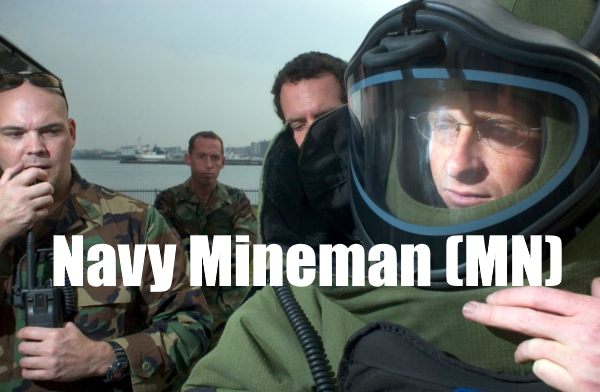Navy Mineman (MN) are Navy enlisted men and women who help protect the fleet and commercial vessels by detecting and neutralizing underwater minefields.
Utilizing advanced technologies, Mineman hunt and sweep the ocean floor the world over. This clears the way for not only the fleet but international shipping routes, too.
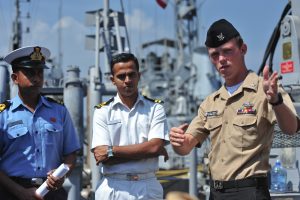
Other duties of Mineman include the testing, assembly, and maintenance of underwater support devices, and the proper repair and performance of the mine.
The Navy Mineman community is extremely small, with fewer than 1000 Mineman in the entire US Navy.
Related Article – Navy Jobs List: A List Of All 71 Ratings In The Navy
Civilians often mistake Navy Mineman with Navy Explosive Ordnance (EOD) Technicians.
Navy EOD training is much more intense and physically taxing. While Navy EOD Technicians are not part of the Special Operations Command (SOCOM), they often work closely with SOCOM.
Instead, Navy EOD Technicians are part of the Naval Special Operations community, like Navy SEALS.
Jump To A Section
Requirements and Qualifications
To become a Navy Mineman, there are specific requirements and qualifications that you must meet:
- Must be a US Citizen.
- Must be a member of the US Navy.
- Must be between the ages of 18 and 39.
- Must have normal color perception.
- No record of adversely adjudicated drug abuse offenses.
- Must have an Armed Forces Vocational Aptitude Battery (ASVAB) score of VE (Verbal Expression) + AR (Arithmetic Reasoning) + MK (Mathematics Knowledge) + MC (Mechanical Comprehension) = 210 or AR (Arithmetic Reasoning) + MK (Mathematics Knowledge) + EI (Electronics Information) + GS (General Science) = 210
- Must be able to meet all security clearance requirements (Secret Clearance is the minimum).
Related Article: Navy Height And Weight Standards
Training and Career Path
Prior to becoming a Navy Mineman, you must first become a US Navy Sailor. Recruits accomplish this via successful completion of recruit training, commonly referred to as Boot Camp.
All sailors attend Boot Camp at the Recruit Training Command, Great Lakes (RTC Great Lakes).
Located at Naval Station Great Lakes in North Chicago, Illinois in Lake County. RTC Great Lakes is commonly referred to as “The Quarterdeck of the Navy.
Boot Camp is eight weeks long. During these eight weeks, the Navy will teach you the basic skills required of all US Sailors.
Related Article – Is Navy Boot Camp Hard?
Navy Mineman Class “A” School
After Boot Camp, Navy Mineman head to the Mine Warfare Training Center (MWTC), at Naval Base Point Loma, Surface, and Mine Warfare Training Center-Complex, San Diego, California.
The Mine Warfare Training Center (MWTC) originally in Ingleside, Texas relocated to San Diego in 2005.
Navy Mineman Class A school is 19 weeks long.
During Navy Mineman Class “A” School training, sailors learn basic skills in locating and neutralization of mines through classroom training and group discussion.
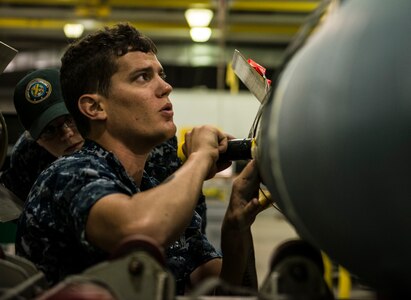
Besides Navy Mineman Class “A” school, the Navy expects and encourages it’s Mineman to complete self-paced Non-Resident Training Courses (NRTC) and relative Personnel Qualification Standards (PQS) when they get to the fleet to enhance their knowledge and increase their promotion opportunities.
These include several General and Watch Standing Qualifications such as:
- Shipboard Fire Fighting
- General Damage Control
- Advanced Damage Control
- 3M (Maintenance, Material & Management) – 301
- 3M (Maintenance, Material & Management) – 302
- 3M (Maintenance, Material & Management) – 303
- 3M (Maintenance, Material & Management) – 304
- Messenger of the Watch (MOOW)
- Petty Officer of the Watch (POOW)
Navy Mineman should also get their Surface Warfare Specialist (ESWS).
In addition, The Navy provides online training to qualified Navy Mineman through their Credentialing Opportunities On-Line website, referred to as Navy COOL.
Navy Mineman-related Class “C” and “F” schools exist for Navy Mineman as they progress in their careers. These schools are at Naval Base Point Loma, Surface, and Mine Warfare Training Center-Complex, San Diego, California, too.
How Much Are Navy Mineman Paid?
Like all other enlisted personnel (in all branches), the Navy bases a sailor’s pay on their rank and length of service.
Navy Mineman may be entitled to other forms of compensation including base allowance for housing (BAH), base allowance for subsistence (BAS), and billet pay (sea pay, flight pay, hazardous duty pay, etc.) if eligible.
Related Article: Navy Ranks And Pay For 2019
What’s Life Like as a Navy Mineman?
Navy Mineman commonly work closely as a team, ordinarily in a small shop-type setting. Either at sea or on shore, the work requires both mental and physical talents.
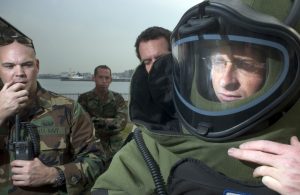
The duties of a Navy Mineman vary widely and include:
-
- Performing routine maintenance on underwater mines and associated equipment, guns, gun mounts.
- Assemble, test, stow, and transport underwater mines.
- Handle surface equipment, mine countermeasures equipment and surface sonar equipment and small arms.
- Participate in fleet mining and exercise training programs.
- Perform safety criteria testing on material handling equipment.
- Train, direct, and supervise personnel in the ship’s maintenance duties in all activities relating to painting, seamanship, marlinspike, ship maintenance, upkeep of the ship’s external structure, rigging, deck equipment, and boats.
- Perform basic seamanship tasks.
- Direct crew in operation of handling rooms, guns, ammunition hoists, and gun mounts.
- Test and inspect gun ammunition.
- Supervise personnel in handling and stowage of gun ammunition.
- Inspect and repair magazine sprinkler systems.
- Perform Plotters and Radiotelephone talkers duties.
- Interpret radar presentations, evaluate tactical situations, and make recommendations to superiors during watch conditions.
- Maintain Combat Information Center (CIC) displays of strategic and tactical information.
- Handle and operate deck-loaded mine neutralization equipment.
- Solve complex electronic problems when systems fail.
- Advise staff and command on matters of operations and personnel.
- Operate, manipulate, control, evaluate, and interpret data, surface sonar and other oceanographic systems.
- Work with basic mechanic hand tools, electrical meters and electronic test equipment.
- Operate mine handling equipment such as forklifts, cranes and heavy transport trucks.
- Perform required functions in the minesweeping tactical nerve center (CIC).
- Provide technical information and assistance related to Mine Warfare and search and rescue operations.
- Provide technical information and advice on capabilities, limitations, reliability, and operational readiness.
The reason that there are so many widely different duties that Mineman must perform onboard ship is that the ships that Mineman are assigned to have such a small crew complement (under 100) to handle all the requirements of a U.S. Naval vessel.
Related Article – Navy Explosive Ordnance Disposal (EOD) Technician: Career Details
Mineman, while on sea duty, will primarily serve on only two types of ships, Avenger-class mine countermeasure ships, known as MCMs, or Littoral Combat ships, known as LCSs. The newer LCSs are gradually replacing the Navy’s MCMs.
As they progress in their Navy careers, Mineman will mentor, lead, and supervise less senior Navy personnel in their Department/Division. Higher-level clearances may also be required.
Sailors in specific jobs (or rates as the Navy refers to them) must adhere to a Sea/Shore rotation based on their rate.
During a twenty-year career in the Navy, Mineman will spend about 60 percent of their career on minesweepers, and 40 percent assigned to shore stations.
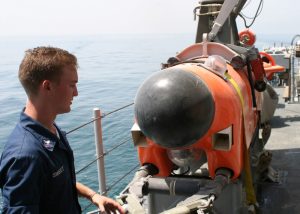
Typical Rotation
Specifically, the Sea/Shore rotation for Navy Mineman is:
| Tour | Sea Tour | Shore Tour |
|---|---|---|
| First Tour | 36 Months (3 Years) | 36 Months (3 Years) |
| Second Tour | 48 Months (4 Years) | 36 Months (3 Years) |
| Third Tour | 42 Months (3.5 Years) | 36 Months (3 Years) |
| Fourth Tour | 36 Months (3 Years) | 36 Months (3 Years) |
| Fifth Tour | 36 Months (3 Years) | 36 Months (3 Years) |
| Sixth Tour | 36 Months (3 Years) | 36 Months (3 Years) |
| Seventh Tour | 36 Months (3 Years) | 36 Months (3 Years) |
Sailors who have completed four sea tours will serve 36 months at sea followed by 36 months on shore until retirement.
Note that some overseas assignments count as sea tours.
Shipboard and life while on shore duty are drastically different. The Navy expects Mineman to adapt and meet the challenges presented by these different environments.
Navy Mineman enjoy the same benefits as do all their shipmates such as the opportunity to travel the world, unlimited opportunities for learning and advancement, and control over their career.
Here are a few reviews we happened across on indeed.com for a Navy Mineman:
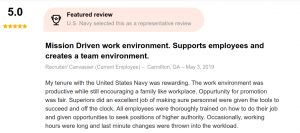



Mine hunting is a laboriously slow task that requires the minesweeper to stay in a limited area until it is entirely mine-free.
The Navy estimates that since 1945, mines have sunk close to four times more US ships than all other threats combined.
According to the Navy, there are more than a quarter million sea mines of almost 300 different types in the inventories of navies around the world. These figures are for sea mines only and do not include underwater improvised explosive devices often fashioned from 50-gallon drums, fuel bladders, or even discarded drums.
However, these dangerous challenges must be faced head-on. Navy Mineman are vital to this effort.
Fortunately, the Navy has Mineman qualified and eager to take on the challenge.
“I enjoy mine hunting and using my training to utilize my skills while we are underway,” says USS Champion (MCM-4) MN3 Ethan McGregor.
MN3 McGregor adds, “Patience is important when you’re doing the kind of work we do. Having good communication skills is also key to working well with others.”
Civilian Career Opportunities
Civilian career opportunities for Navy Mineman are as varied as they are onboard MCMs and LCSs for Navy Mineman.
This is especially true if Mineman take full advantage of on-the-job (OJT) training and educational opportunities afforded them during their service. Just a few civilian career opportunities include:
- Electric Motor, Power Tool, and Related Repairers
- Explosives Workers
- Ordnance Handling Experts
- Blasters
- Hazardous Removal Workers
- Riggers
- Logisticians
- Transportation Managers
If you are a young person considering joining the US Navy, life as a Navy Mineman is rife with adventure, challenges, and opportunities along with a variety of day-to-day duties and responsibilities.
References
- Gas Turbine Systems Technician (GSM and GSE): Career Details - June 18, 2024
- Interior Communications Electrician (IC): 2023 Career Details - June 18, 2024
- Religious Program Specialist (RP): 2023 Career Details - June 18, 2024

